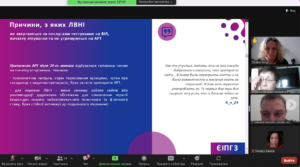With the onset of the full-scale Russian invasion, the migration of people who use drugs by injection (PWID) between regions of Ukraine increased, and the risks of them discontinuing HIV treatment and receiving HIV services in general increased.

Considering the current challenges, there is a demand for improvement of already existing or introduction of new interventions for PWID under the age of 25 and women who inject drugs (WWID), which would contribute to early detection of HIV, timely initiation of treatment and maintenance of ART of target groups, especially in war conditions.
On January 4, 2023, our experts presented the results of a qualitative study devoted to these issues, which was conducted by the European Institute of Public Health Policy in partnership with the Public Health Alliance in 2022.
A full report on the results of the study is available on our website at the link:
In the report, read in detail about:
- Profiles of young PWID who are not tested for HIV, have not started treatment or are not continuing it;
- Profiles of WWID who are not tested for HIV, have not started treatment or are not continuing it;
- HIV Testing: perceptions, barriers and motivation;
- ART initiation: facilitators and barriers;
- Adherence to ART: obstacles and difficulties in regular intake of drugs;
- The role of specialists and the immediate environment in the initiation and regular reception of ART;
- Information channels and messages about HIV testing and treatment;
- Participants’ proposals for improving the detection and treatment services;
- The needs of PWID in related services: ART, treatment of hepatitis and STIs.
